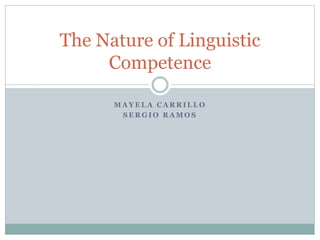
The nature of linguistic competence
- 1. M A Y E L A C A R R I L L O S E R G I O R A M O S The Nature of Linguistic Competence
- 2. The Universality of Human Language All languages are similar in their organization and in their function: Every human language has a lexicon and a grammar to create sentences. Knowledge of the grammar and lexicon = person’s linguistic competence.
- 3. Grammar Is composed by: Phonological component (containing rules and principles related to regularities of sound system of language) Morpholoical component (contains rules governing the modification of the forms of words) Syntactic component (contains rules and principles that create sentence structure)
- 4. Languages Vary in a few ways Like Sentence structure: English: Subject + Verb + Object Vs Japanese: Subject + Object + Verb Differences among large classes of languages are called Parameters
- 5. Universal Grammar Is the representation of all the universal characteristics of human languages. Consists of a collection of characteristics of language that are the same in all languages (general principles of organization and operation) and a collection of dimensions of variation (parameters).
- 6. The Phonological Component of the Grammar The fundamental genius of human languages: take meaningless units related to sound and combine them to produce meaningful units like words.
- 7. Some Concepts to Pay Attention to: Phones: represent an individual speech sound. Phonemes: classes of phones that serve the function of keeping words distinct from one another. They are written between slashes to distinguish them from phones. Example: /b/ &/p/ in the words big and pig
- 8. Minimal Pairs: different words in which two phonemes contrast in the same position. Example: pig and big, bill and pill. Phonetic Transcription: method for representing units of sound. These units are placed between brackets
- 9. Allophones: is one of a set of a multiple possible spoken sounds (or phones) used to pronounce a single phoneme. They are not themselves phonemes because they don’t keep words apart; they are not in contrastive distribution, but in complementary distribution. Examples: /p/ in spin and /p/ in pin.
- 10. Basic Role of the Phonological Component of the Grammar Is to specify the phonemic inventory of the language, which is a list of all the classes of speech sounds in the language that are contrastively distributed. Phonemic inventory of a language has a profound effect on a speaker´s perception of speech sounds.
- 11. Classification The phones of a language can be classified according to characteristics of their production. The most basic: Consonants & Vowels
- 12. Roles of the Phonological Component of The Grammar Specify the speech of sounds that represent the words of that language. Set constraints on what sequences of phonemes will be possible in the language.(Phonotactic constraints of language) Provide detailed information about exactly how speech is to be produced.
- 13. Phonological Rules There are regular phonological patterns of the language, like: -All voiceless stops that begin a word will be aspirated, but those that do not begin a word won’t. -Every word would have a syllable that is stressed more than others. The job of the many phonological rules is to specify the predictable phonetic details of pronunciation.
- 14. Related to pronunciation: Prosody Some words get more stress than others, and the entire sentence would have a pattern of intonation that is reflected in the way the fundamental frequency of voice rises and falls while it is spoken. It is predictable by phonological rules.
- 15. Morphemes Are the smallest units of meaning or grammatical function in a language. The morphemes can be divided into two classes: bound and free.
- 16. Types of Morphemes Free morphemes are individual words (the, dog), while bound morphemes must be affixed to words (“s” in plays, “re” in rewrite). There are two kinds of bound morphemes: Inflectional and derivational.
- 17. Inflectional Morphemes Inflectional morphemes are those required as an aspect of sentence structure (-ed in kissed, -s in loves). Inflectional morphemes play grammatical roles required by the structure of a sentence; the inflection simply adds information to the stem without changing the meaning of the stem.
- 18. Derivational Morphemes Derivational morphemes can change both the meaning and the part of speech of the stem to which they are attached (-er in words like killer and writer). Some derivational morphemes change meaning of a word without changing the part of speech (un- as in unhappy, unwilling).
- 19. The morphophonological rules specify the actual pronunciation of morphemes when they are combined in a word.
- 20. The Syntactic Component of the Grammar The syntax of a language creates the structure of its sentences, which, along with the words with them, determine the meaning of each.
- 21. Basic Operations Creates the basic structures of sentences. Gives human language its creativity. Gives people the ability to create sentences with great precision of meaning.
- 22. Concepts: Sentence: structure consists of the hierarchical organization of constituents Constituents: are components of the sentence that form a unit.
- 23. Argument: A basic sentence consists of a single verb and the grammatical elements that must appear with the verb for the sentence to be well formed. These grammatical elements are called arguments of the verb and all verbs require at least one argument, a subject.
Notes de l'éditeur
- Explain further about the phonemic inventory profound effect.
- Explain further how they are produced.
